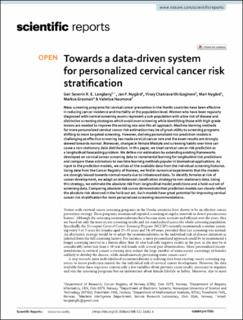| dc.contributor.author | Langberg, Geir Severin Rakh Elvatun | |
| dc.contributor.author | Nygård, Jan Franz | |
| dc.contributor.author | Gogineni, Vinay Chakravarthi | |
| dc.contributor.author | Nygård, Mari | |
| dc.contributor.author | Grasmair, Markus | |
| dc.contributor.author | Naumova, Valeriya | |
| dc.date.accessioned | 2023-02-02T09:06:28Z | |
| dc.date.available | 2023-02-02T09:06:28Z | |
| dc.date.created | 2022-08-16T10:59:52Z | |
| dc.date.issued | 2022 | |
| dc.identifier.citation | Scientific Reports. 2022, 12 (1), . | en_US |
| dc.identifier.issn | 2045-2322 | |
| dc.identifier.uri | https://hdl.handle.net/11250/3047901 | |
| dc.description.abstract | Mass-screening programs for cervical cancer prevention in the Nordic countries have been effective in reducing cancer incidence and mortality at the population level. Women who have been regularly diagnosed with normal screening exams represent a sub-population with a low risk of disease and distinctive screening strategies which avoid over-screening while identifying those with high-grade lesions are needed to improve the existing one-size-fits-all approach. Machine learning methods for more personalized cervical cancer risk estimation may be of great utility to screening programs shifting to more targeted screening. However, deriving personalized risk prediction models is challenging as effective screening has made cervical cancer rare and the exam results are strongly skewed towards normal. Moreover, changes in female lifestyle and screening habits over time can cause a non-stationary data distribution. In this paper, we treat cervical cancer risk prediction as a longitudinal forecasting problem. We define risk estimators by extending existing frameworks developed on cervical cancer screening data to incremental learning for longitudinal risk predictions and compare these estimators to machine learning methods popular in biomedical applications. As input to the prediction models, we utilize all the available data from the individual screening histories.Using data from the Cancer Registry of Norway, we find in numerical experiments that the models are strongly biased towards normal results due to imbalanced data. To identify females at risk of cancer development, we adapt an imbalanced classification strategy to non-stationary data. Using this strategy, we estimate the absolute risk from longitudinal model predictions and a hold-out set of screening data. Comparing absolute risk curves demonstrate that prediction models can closely reflect the absolute risk observed in the hold-out set. Such models have great potential for improving cervical cancer risk stratification for more personalized screening recommendations. | en_US |
| dc.language.iso | eng | en_US |
| dc.publisher | Nature | en_US |
| dc.rights | Navngivelse 4.0 Internasjonal | * |
| dc.rights.uri | http://creativecommons.org/licenses/by/4.0/deed.no | * |
| dc.title | Towards a data-driven system for personalized cervical cancer risk stratification | en_US |
| dc.title.alternative | Towards a data-driven system for personalized cervical cancer risk stratification | en_US |
| dc.type | Peer reviewed | en_US |
| dc.type | Journal article | en_US |
| dc.description.version | publishedVersion | en_US |
| dc.source.pagenumber | 0 | en_US |
| dc.source.volume | 12 | en_US |
| dc.source.journal | Scientific Reports | en_US |
| dc.source.issue | 1 | en_US |
| dc.identifier.doi | 10.1038/s41598-022-16361-6 | |
| dc.identifier.cristin | 2043328 | |
| cristin.ispublished | true | |
| cristin.fulltext | postprint | |
| cristin.qualitycode | 1 | |

